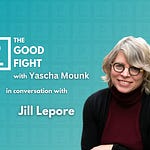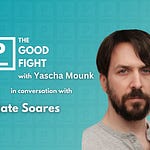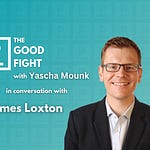Sabrina Tavernise is a national correspondent for The New York Times. She covered the Iraq War for the Times, where in 2005 she was one of the first people to document ethnic cleansing, and has reported on life in post-Soviet Russia for a variety of publications. She was a first-hand witness to the storming of the U.S. Capitol.
In this week’s conversation, Sabrina Tavernise and Yascha Mounk discuss Tavernise’s experience in the Capitol on January 6, the roots of violence and civil war around the world, and why peace is elusive once violence becomes the norm.
This transcript has been condensed and lightly edited for clarity.
Yascha Mounk: You are, I think, the only human being I know who stormed the Capitol on January 6, not as part of the great Trumpist attempt to “Stop the Steal,” but as a journalist. Tell us about the day and your experiences.
Sabrina Tavernise: January 6 was a very strange day, as it turned out, but it didn’t really start that way.
I was caught off guard by how well-attended it was. I was thinking, “Okay, it’s another one of these things, you know, it’s not going to be a big deal.” And when I got down there, probably around seven in the morning, it was people as far as the eye could see.
Mounk: We’re not yet talking about the sort of people who storm the Capitol. We’re talking about the people who went to hear Donald Trump.
Tavernise: Exactly. Effectively, it was a giant rally. In retrospect, there were people who had very specific plans about the Capitol, but most people didn’t. Most people had rolled up from driving all night from [places like] central Texas, and were blearily stomping around in what was a very cold morning. [It was] very windy, and very hard to hear Trump. Most people I was standing around had no idea what he had said, and they also had to go to the bathroom very badly, because they’d been standing in line since 5 a.m. And at this point, it was like 1 p.m. For most people I was talking to, there wasn’t really a plan. But at some point, before the end of the speech, some people started shouting, “Let’s go to the Capitol! They’re voting, they’re voting! Let’s go to the Capitol.”
They needed a bathroom, they couldn’t hear Trump. It was freezing. And also Trump wasn’t saying anything new. I heard this one guy saying, “That’s it? We thought the truth was going to be revealed today, by you! There’s supposed to be an answer today.”
Mounk: [Did] they know you’re from The New York Times?
Tavernise: It’s a little similar to how I experienced interviews in Russia in the 1990s, which is, “Oh, you’re with The New York Times? Those guys are terrible. But anyway, let me tell you about why I’m here today.” They have something to say and whoever you are, they want to say it to you. In all of those Trump rallies I was in, I can count on one hand the number of times someone said “No, I’m not going to talk to you, from The New York Times.” I did not encounter anybody who refused to talk to me that day. Everybody was very talkative. And so I was walking with this off-duty police officer who came to attend the rally. I stopped for a little bit to talk to a guy who redid flooring in central Massachusetts, and his friend who was an emergency room nurse.
And I started seeing these people coming toward me who had wet faces. And when I came closer to them, I realized the liquid was white. It was milk that they had poured on themselves. So I thought, “Oh, my God, there’s tear gas.” So I broke off from the police officer and trotted up to the front and the first thing I see is about 12 unmarked police vehicles and vans with police in riot gear coming out, going toward the Capitol.
I’m walking in the direction of the crowd, and I’m watching them react to these police officers. I’m standing essentially on the Union Station side and Pennsylvania Avenue side. I’m standing, actually, in the spot where the original break-in was, but I didn’t see it immediately. I saw people pounding on the windows on the Senate side, one guy was saying, “Wake up and make the coffee, we’re coming in!” There was another guy kind of ogling the chairs, and the ergonomic keyboards and the fancy furniture, saying “Oh my God, look at how they live and look at how they work!” And the banging on the windows was very hard. And I kept walking along this window ledge with the people banging, and then turned the corner and came upon what we know now, in retrospect, to be the first break-in place, which was the little crevice on the northwestern side. It was a window that was originally broken. And then people from the inside broke the door, opened it up to the outside. And I was one of the people who walked through the door, at about 2:30 p.m.
There was broken glass. There was water all over the place because people had been pouring bottles of water in their faces from the tear gas. There were people lying on the ground because they’d been tear-gassed and they were trying to get their breath. There was a desk knocked over and broken up. There was no authority anywhere. That, to me, as someone who had been in war zones for a long time, was deeply frightening. We know that crowds can be very unpredictable and very dangerous. The original people who broke in had already moved on. There were a lot of women. There were people of all ages, one police officer, and everybody desperately needed to go to the bathroom. So everybody was swarming this police officer saying, “Hey, where’s the bathroom? Where’s the women’s room, the men's room?” And the little police officer [said], “That way.”
I said, “Should you be kicking them out?” And he just gave me this look like, “Well, what do you want me to do, lady? It’s one of me, a couple hundred of them.” There was this very long line for the men’s room that I saw. I was in a little anteroom [belonging to] one of the senators—it wasn’t the main office of the senator—and there was a group of people in there, sitting around. It felt to me a little bit like a party in high school with the bad kids. Somebody was ripping this Chinese-lettered scroll off the wall, somebody else stole a framed photograph of the Dalai Lama. People were making fake phone calls saying, “I’m going to call this senator, that senator,” “Oh, man, look at this office. It’s so nice.” The whole atmosphere generally was menacing, because, quite simply, there were no authorities. But it wasn’t as though they saw me and said, “Let’s get rid of this journalist.” I ended up in the crypt, which is the place in between the House and the Senate. It’s not the rotunda, but it’s the columned, round, low-ceilinged area in between. And I’d say there were maybe 200 people in there when I was there. Of those 200 people, most of them were standing around just chewing the fat, taking selfies. There were a couple who were very hyped up. One older man, I’d say probably in his 50s, was running around shrieking. At the time that I got in, I’d say there were five to seven police officers. So there was really nothing that they could do.
There were incredibly violent scenes in different parts of the building. I have a photographer friend who actually got stuck in that. I don’t know if you saw The New York Times January 6 montage, but there was body camera video from a police officer of people pushing through an area that was directly where the inauguration was going to be—a doorway. And he said he raised his arms up to be able to shoot with his camera. It was a small space, and it was a big, intense, packed crowd. And he said that he started to panic because he could not get his arms back down, and he thought his ribs were going to break. There were parts of the building where very violent things were happening, [but] I was not in one of them. I was able to talk to people a little bit and chronicle what I saw going on, but I don’t mean to minimize the violence because it was, in retrospect, quite savage in a lot of the places, particularly against the police officers.
Mounk: I think the role of the police and the discourse about them is one of the very complicated things about January 6. The impression at the beginning that they had somehow been complicit has turned out to be probably wrong. But I think they were very scared.
Tavernise: My impression was [that] they were completely terrified. And I think that the people who were consuming what The New York Times was writing that day were very much in the mood to think that the police were complicit. But [in] my experience with it ... they were shit-scared. There were not enough of them. They need a critical mass of people in order to be able to safely control a crowd, and they didn’t have that. And the people who were inside were doing their level best to not have anybody end up dead. Fundamentally, that was what it was about. Because it was clear that they were overwhelmed. And I think it could have been much worse in that respect.
Mounk: How do we think about the broader significance of January 6? Because I have to say that I very strongly go back and forth on it. Clearly, storming one of the central places of American democracy by a crowd of people whipped up by the outgoing president intent on stopping the certification of an election result, is a very, very extreme event. [But] there is a way of thinking about January 6 [as] a terrible security failure. It’s obviously a testament to how divided the country already was, but if they just had 500 more policemen, and if it just had sensible security, the whole day seems like it would have passed as a blip. I struggle with how to get those two halves of a narrative into my head together at the same time. What do you think about that?
Tavernise: In some ways, does it matter? I talked to a lot of conservatives about January 6, including people who [participated]. I’m still in touch with five or six people; I text with them on a regular basis. They insist that we need to remember that day exactly how they experienced it. And the only thing they saw with their own eyes was walking inside, looking around the rotunda and walking out. They say, “I didn’t see any violence. For me, it was peaceful.” And for many people, it was peaceful. And then I argue with them, saying, “OK, maybe for you it was peaceful.” But the thing that matters for the history books, and the way that everybody will remember it, is that people died, and that there was violence in it. When violence happens, that creates a chemical reaction that changes everything.
Mounk: You’re somebody who has spent much of your career as a foreign correspondent living outside the United States. You spent time in Russia and Turkey, some time in Lebanon and other places. But coming back to the United States, you suddenly felt like your experience of covering deeply divided societies gave you insight into the United States. [The U.S.] suddenly felt similar to both societies in a way that it hadn’t done when you were growing up here. What lessons can we take from these deeply divided societies? And how can we make sure that we have empathy for our fellow citizens who are on the other side of a political divide without excusing the most reprehensible actions?
Tavernise: I moved to Russia when I was 24 years old, and I started in journalism when I was 26. And I didn’t really know very much about the way the world worked at that point. And I feel like I kind of went out into that society speaking very good Russian—my Russian was very fluent—without very much humility, and with a lot of arrogance about who they were and how they were supposed to get their act together. I remember traveling to these little provincial towns, and I’d be writing about an aluminum plant or an oil company or a local election. And I remember thinking and writing in this way, “You know, guys, the widget factory is never coming back. I know everybody wants the widget factory because that was what was comfortable and safe. But that was a communist thing, and communism is over. You really need to get your act together. Why don’t you just go out and kind of invent something? Go out and build a business, go out and rearrange your life and your town in a way that will make you prosperous and more like us.”
When I first came back to the United States, I’d been gone for the better part of more than a dozen years. And I started talking to Americans, also in provincial places, and I realized they were saying, “Oh, if only the widget factory that was here in the 70s, in the 80s, would come back! If only it would come back, then all of our problems would be gone.” I realized, oh, my God, it was the same thing. It was the same dynamic. And part of that was economic collapse. Part of that was extreme lack of trust in government and in each other.
Another parallel was the disinformation that started to spread in Russia, quite early and very virulently. [With] every person you would talk to, every cab driver, you would get into it: “Gorbachev is actually being run by MI6.” Everybody had a theory of why life was so messed up, and who was responsible, who was to blame. And I remember thinking, “Oh, my God, this is just a bunch of tinfoil-hat stuff. These people were in the Soviet cave for 70 years, and they kind of got a little wacky in there. They didn’t modernize with everybody else.”
[But] more recently, in my own society, people say, “Oh, yeah, the election was stolen? Absolutely. Biden has basically been kidnapped, and there are all these people around him who are actually making the decisions and pulling the strings.” I realized we are absolutely not exceptional in any way. We basically have exactly the same problems and exactly the same group dynamics and exactly the same divides. We were richer and more developed, [but] that didn’t matter. That’s pretty sobering, because now we’re stuck. How do we get out of this situation? No one on the right I’m talking to even thinks that Biden is kind of a sentient, conscious individual. The elections [going forward] are going to be really fraught, because there’s been this poison pill injected into them by Trump, and it’s hard to know where it’s going.
I can’t actually get myself to the place where I can imagine organized political violence in the U.S. When [Iraq] descended into civil war, you had groups that represented in some ways the sects and the political parties’ militia-type wings. I can’t really see that in the U.S. But then if I squint a little bit and think of it as an Impressionist painting, I can kind of get there. At the end of the day, it doesn’t take that many people to make a war and to make violence. And once violence starts, as we know from other conflicts, it begets other violence. Once people start having dead relatives, dead friends. It’s very difficult to stop, because the middle class leaves the country. People are just incandescent with rage and with hatred, and that is a chain reaction. Once it begins, it’s very difficult to stop.
Mounk: When you actually look at the public policy preferences of the average American, they are perfectly reasonable. On virtually every important issue, you have a majority or plurality of Americans advocating for perfectly decent things. One example is [that] the majority of Americans believe that police violence is a real problem, and that we need to find ways of holding bad cops accountable and changing policing methods. Where the elites in Washington [are divided], most Americans see a lot of consensus on this kind of issue. Most people don’t think about parties all that much. A huge majority of Americans never watch Fox News, never watch MSNBC, and never watch CNN. They don’t read The New York Times, they certainly don’t read Persuasion. And perhaps all of that is reassuring, right? Why should this society that cares much more about what’s on Netflix end up in this form of political violence?
Tavernise: That’s why I think January 6 was so disturbing to me, because it just showed that [political violence] is a human condition, and we are not immune to that. Political systems can descend into this, and so can ours. I think that there was that kind of suspended moment right afterward, where everybody was kind of scratching their heads, but it settled into what we now know: It wasn’t really condemned by the Republican Party. And if they’re not condemning it as a big problem, that leaves us completely undefended and unprotected. Should there be another very skilled nationalist leader who wants to scoop up that “Stop the Steal” stuff and use it ... It is a white-hot weapon. It doesn’t really feel so hot now, because we’re very far from the presidential election, but it will heat up and it will be there. I guess my question is, “Who are the leaders who will be there in 2024, carrying that torch forward?” I spent a lot of time with a young man who was part of a militia movement from southwest Virginia. I asked him about Josh Hawley, the senator from Missouri who had been voting not to certify the election and had been quite involved on the Trump side of this, and he had no idea who I was talking about.
I don’t think that any of these guys are household names at all, and I don’t really see any of these guys having the skill and the ability that Trump had, [and] I don’t think it really happens without a leader. But then again, as my colleague who grew up in Alabama always reminds me, we had an authoritarian political system in this country for a very long time, [in the] American South, and there was not one über-leader there: It was a small, grassroots local thing [with] a bunch of local party bosses and mayors and governors.
Mounk: It seems to me that you need probably three conditions for mass political violence (and I’m slightly making this up on the fly). In 2020, perhaps one and a half of them were fulfilled, but three of them might be fulfilled in 2024, 2028, [or] 2032. The first is very deep polarization; that can be any [form of] polarization, but it can certainly take the form of partisan political polarization, as it does currently in the United States. The second, as you’re saying, is a political leader who is whipping this stuff up. I think that’s a condition that was half-fulfilled in 2020. Donald Trump clearly was whipping it up, but, like in every other area of his life, without any concrete plan. He wasn’t actually, in a systematic way, trying to use paramilitary troops to stop the handover of power. Some of the people you spoke about at the beginning of our conversation [who were] disappointed, they were expecting Trump to come and say, “Here’s the plan, guys.” But he never quite had a real plan, so I think that condition was half-fulfilled. And then there’s a third condition, which is a constitutional crisis. You have to have some split within the institutions, which makes it non-obvious which way different parts of the state apparatus are going to go. Thankfully, in 2020, in part because of the real performance of the American judiciary, including many judges that were appointed by Republican presidents [and] courts that were heavily staffed with conservative judges, this wasn’t an opening. The lawsuits were all dismissed, [and] it became very, very clear who the rightful winner was according to the rules of the system. That made it very hard, for example, for an Army commander to say, “Well, I really don’t know who my commander-in-chief is.”
I think the fear for 2024 is that the extent of partisan political polarization will remain similar to what [it] was in 2020. So that condition will still be fulfilled. The second question is, “Who on earth is the 2024 Republican nominee going to be? And will they be a person who might, if they lose the election, claim that the election was stolen as Trump did? And might they even go one step further, trying to plan the disruption of the peaceful handover of power in a more concerted way, in a more strategic way than Trump did?” It certainly doesn’t look entirely out of the realm of possibility. And then the third condition is why I think I ultimately worry more about the state-level laws—not about voter access, but about voter certification—that are being passed around the United States. There [are] many bad voter suppression tactics that we should absolutely be concerned about. But it is really the laws that allow elected political actors to say, “We do not accept the outcome of a result in Arizona, and we’re going to certify that Republicans won here” [that are worrying]. That raises the possibility [of the] third condition, that a real constitutional crisis might be fulfilled when different institutions start to come to different conclusions about who the rightful president is. That, to me, is the real horror scenario.
Tavernise: That certainly feels like the real weak spot. By the way [...] Democrats were completely blown out on the state level. You know, we’re about to have a redistricting right now, [due to] the 2020 census. The Republican Party is very, very well positioned for complete control of state legislatures in large swaths of the country. It seems hard to imagine Ted Cruz or Josh Hawley or anybody who ends up being the Republican president in 2024, if there is one, organizing a militia. I mean, we are not Iraq. We are not Lebanon. On the other hand, maybe there’s a freeform group where lots of people sign on, and they have guns, and there’s a bunch of winking from the side going on from a political leader. I don’t know.
Interviewing people after the election about the quote-unquote “stolen election” felt like a ground-up look at authoritarianism. What does it look like when people are OK with having someone just steal power? Of course, when you look at it from their perspective, they’re not stealing anything. They care about democracy. They care deeply, in fact—so deeply that they got up off their couch and they drove all the way here. And they want to make their voice heard, because they care about this country, and they care about [its] direction. “And if my sacred right to vote was stolen... I don’t know, I’m willing to do just about anything.” That was how people were talking on January 6. You don’t have people walking around with “I’m authoritarian” tattooed on their forehead. That’s really not how they see it. They see a terrible injustice having been perpetrated on them, and they’re trying to right the wrong. How do you fight that?
Mounk: Are there any things we should do as a society—on the level of legislation, on the level of how we treat our fellow citizens, on the level of what kind of political activism we should [engage in]? Do you have any ideas about what action we need so that something like January 6 won’t be repeated?
Tavernise: Try to have more conversations with people who are not part of your political tribe. And I feel like that’s kind of an easy thing to say and a really hard thing to do, particularly now that our society is segregated in a way [where] we just don’t run into people who are unlike us anymore. Even though you might disagree with a person’s political beliefs, or even at times find them unpleasant [or] unpalatable, they are a fellow citizen. They have kids like you. They want good schools like you do. We do have things in common. The social psychologists would tell us [that] we need to find the things that we do have in common, and go back to those things and try to focus on those things. And those things are not politics.
I think talking about politics is not helpful. And we will never agree on it. We need to remember what it means to be Americans, together.
Please do listen and spread the word about The Good Fight.
If you have not yet signed up for our podcast, please do so now by following this link on your phone.
Email: podcast@persuasion.community
Website: http://www.persuasion.community
Podcast production by John T. Williams and Brendan Ruberry
Connect with us!
Twitter: @Yascha_Mounk & @JoinPersuasion
Youtube: Yascha Mounk
LinkedIn: Persuasion Community













